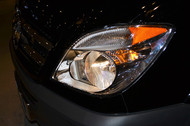HID vs LED Headlights: Which Is Best?
10th Jun 2021

You don't have to use your vehicle's factory headlights. You can upgrade your car with aftermarket headlights, such as high-intensity discharge (HID) and light-emitting diode (LED). HID and LED have become popular alternatives to traditional halogen headlights. They still use the same electrical connections, and they still produce illumination. What's the difference between HID and LED headlights exactly?
What Are HID Headlights?
HID headlights are characterized by their use of xenon to produce illumination. They contain tubes that are filled with xenon gas. When supplied with electricity, HID headlights will produce illumination. Electricity will cause the xenon gas within the tubes to light up.
What Are LED Headlights?
LED headlights are characterized by their use of a photon-emitting semiconductor to produce illumination. They don't have a filament, nor do they have gas-filled tubes. Rather, LED headlights have a semiconductor that releases photons when powered by an electrical source.
Differences Between HID and LED Headlights
In terms of brightness, HID headlights come out on top. They are capable of producing more illumination than their LED counterparts. If you regularly drive at night, you may want to choose HID headlights for this reason With HID headlights, you'll be able to see the road more clearly thanks to their superior brightness.
HID headlights are less expensive than LED headlights. Both types of headlights cost more than traditional halogen headlights. Nonetheless, HID headlights typically cost less than LED headlights. If you're on a budget, you may want to choose HID headlights with which to upgrade your vehicle.
LED headlights, however, are more energy efficient than HID headlights. They consume a fraction of the energy as HID headlights. This means LED headlights will place less of a strain on your vehicle's battery.
Not only are they more energy efficient than HID headlights, LED headlights produce less heat as well. Some types of headlights can get hot. Halogen headlights feature a filament that heats up. Even HID headlights will produce heat as electricity flows through the xenon gas. With that said, LED headlights produce the least amount of heat.
Another benefit of choosing LED headlights is longevity. Depending on the specific type, LED headlights can last for 20,000 to 50,000 hours. HID headlights, on the other hand, have an average lifespan of about 10,000 to 15,000 hours. The long lifespan of LED headlights makes them a popular choice among motorists.



